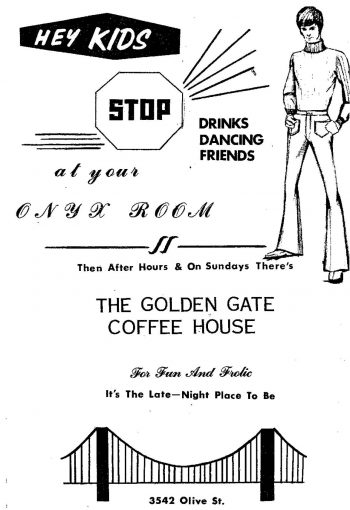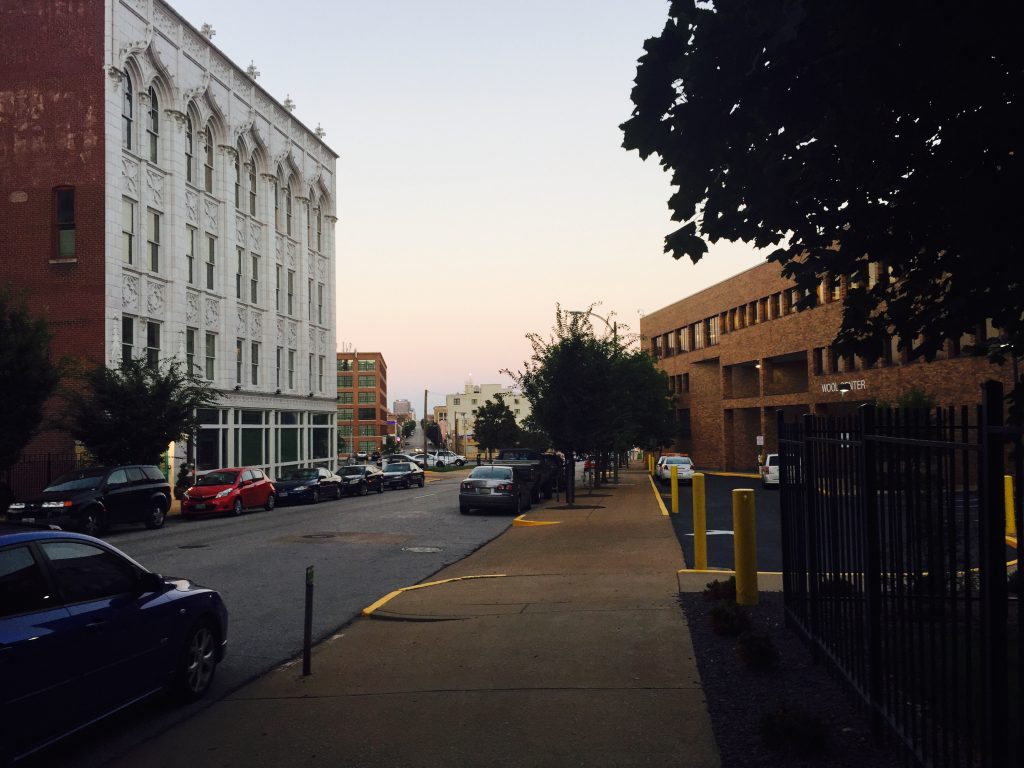
“In This Part of the City, All the Fellows Are Gay:” Exploring the History of LGBTQ Nightlife at St. Louis’s Grand and Olive [3/3]
The 3500 block of Olive flourished as an LGBTQ nightlife destination in the 1950s, 1960s, and 1970s.
At around the same time that Dante’s Inferno closed, several new lesbian and gay establishments opened on the block. During this period, the nearby Central West End also solidified its reputation as St. Louis’s “gay ghetto,” home to an unusually large number of LGBTQ residents and businesses. For some, the bars on Olive marked the eastern border of the “gay ghetto.”

In these years, popular nightspots on the block included the Golden Gate Bar (later the Golden Gate Coffee House), Shelley’s (also called the Midway and Gus’), Act IV Coffee House, and the Onyx Room. Other LGBTQ and LGBTQ-friendly bars, restaurants, and coffeehouses were on nearby blocks. These establishments remained in business after 1959, when the nearby Mill Creek Valley neighborhood was largely demolished as part of a “slum clearance” or “urban renewal” project. For years afterward, much of the former Mill Creek Valley consisted of empty, grass-covered lots, earning it the nickname “Hiroshima Flats.”
LGBTQ people from throughout the St. Louis area and beyond gravitated toward the 3500 block of Olive.
In an oral history, Georgia King—a lesbian who frequented the area in the 1950s—recalled that the bars there “were really something else. You’d just hop from one bar to the next.” Grand and Olive was a place where LGBTQ people could meet others who were like them, pursue sex and romance, and build friendships and community. In a world where they often felt alone and out of place, many LGBTQ St. Louisans found a sense of security and belonging on the block. In a 1969 police report, a man arrested for dressing in drag outside of the Onyx Room asserted that “in this part of the city all the fellows are Gay.”
In her semi-autobiographical novel A Crystal Diary, Frankie Hucklenbroich vividly describes visiting the 3500 block of Olive with a group of other teenage lesbians in the late 1950s. Too young to enter the bars, they gathered outside on the street instead:
“Baby butches, breath steaming and pluming about our shoulders, cheeks red, huddling awe-stricken on the corner of Grand and Olive in the sleety late winter/early spring of 1957 downtown St. Louis, watching the grown-up lesbians parade in and out of Shelley’s Bar. The femmes—even the occasional homely ones—look so beautiful to us, like twittering Birds of Paradise. High heels click. Lush mouton coats the color of root beer cover angora sweaters. Full skirts swing, earrings sparkle. The butches sport suede jackets, wool car coats with wood buttons, shirt with turned-up collars, penny loafers or wingtips, nifty “pegger” pants …. A few of them even wear jackets and ties, snappy. … [Nearby] is the Golden Gate Bar, also gay, but unimportant to us because it is where only gay men go, though that corner, too, is crowded with bleating adolescent homosexuals—male type.”
Despite their proximity to Black residential neighborhoods, the bars on the 3500 block of Olive could be unwelcoming to non-white customers in the 1950s. In her oral history, Georgia King reports that the bars were “all white” and that the manager of Shelley’s “nearly had a stroke” when she once tried to bring a Black woman into the bar with her. King recalled that the manager had said he was afraid that the other customers would “get up and walk out” if he began serving Blacks. The segregation of St. Louis’s LGBTQ social spaces reflected the Jim Crow practices of the dominant culture. However, the racial character of the block was not static. By the late 1960s, some of the bars appear to have become racially integrated, and in the late 1970s the Onyx Room was described as “predominantly black” in a directory of local gay businesses.
While they were almost certainly aware that they served an LGBTQ clientele, city officials allowed the bars on the 3500 block of Olive to remain open.
Local authorities probably were willing to tolerate the bars there because the surrounding area was “run down,” on the edge of a slum clearance zone, and at a distance from where most of the city’s financially secure, white families lived. Still, the police did sometimes raid the bars and harass their employees and customers. Some sources suggest that police officers also collected bribes from bar owners. In A Crystal Diary, Hucklenbroich describes the police presence on the block like this:
“Sporadic bar raids, rare corner warnings just to look good, beat cops walking heavy-footed by both corners most the time not bothering anybody, just dirty looks as they go into Shelley’s and the Gate, sashay out in a few minutes with fat envelopes. Send the kids to a summer camp, buy the wife a new washing machine, leave the queer sprouts on the corners alone.”
One particularly important encounter between the police and patrons of the Grand and Olive bars took place on Halloween night, 1969.
Police arrested a group of nine young people dressed in women’s clothes as they exited the Onyx Room. At the time, “masquerading”—dressing in the clothes of the opposite sex—was prohibited by a municipal ordinance. The Mandrake Society—a gay rights group founded in the Central West End the previous April—sprang into action that night. Spreading word of the incident by phone, members of the Mandrake Society and other supporters gathered at police headquarters downtown and demanded that those arrested be released. This is the first known public protest by gay activists in the history of St. Louis. The Mandrake Society assisted with bail, then hired a lawyer who later convinced a judge to drop the charges. This was a crucial early victory for the local gay and lesbian rights movement and contributed to a flowering of LGBTQ activism in St. Louis in the 1970s.
As the 1970s progressed, LGBTQ nightlife on the 3500 block of Olive seems to have lost steam.
In part, this was because the bars there lost customers to new establishments in the Central West End and in other parts of the St. Louis area. At the same time, the city’s movers-and-shakers were increasingly eyeing Grand Center as a possible locus of redevelopment.
By the close of 1980, all the bars on the block had gone out of businesses, and most of the buildings there had been demolished to make way for the construction of a new state office building. More than four decades of LGBTQ nightlife at Grand and Olive had come to an end.

Author Ian Darnell is a PhD candidate University of Illinois at Chicago & graduate researcher for Mapping LGBTQ St. Louis
“In This Part of the City, All the Fellows Are Gay” is a three-part essay about the history of LGBTQ nightlife at St. Louis’s Grand and Olive. The title quote comes from a 1969 police report, when a man arrested for “masquerading” (i.e., dressing in drag) reportedly told a vice officer that “in this part of the city [i.e., the 3500 block of Olive and vicinity] all of the fellows are Gay.”
